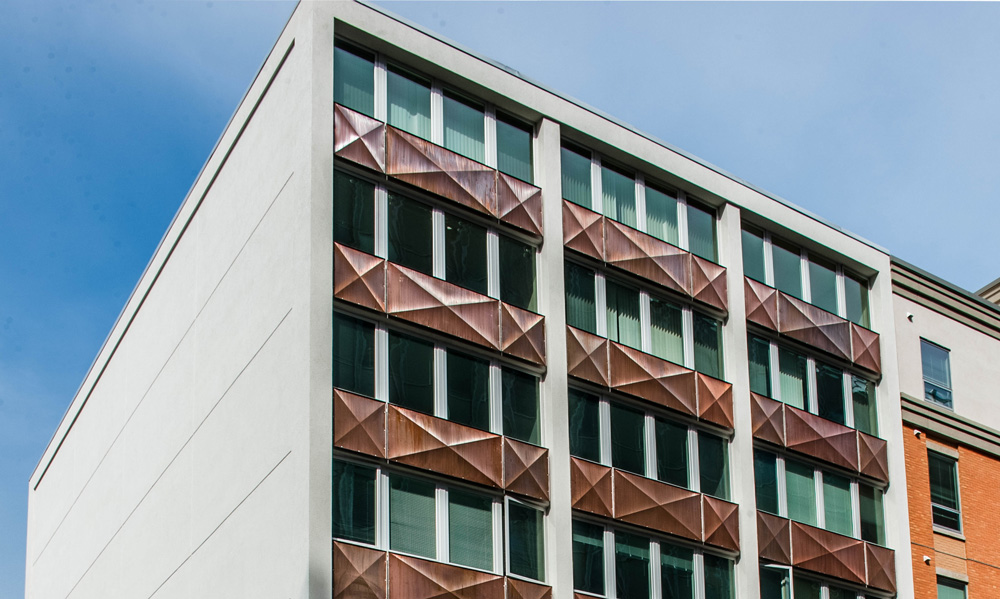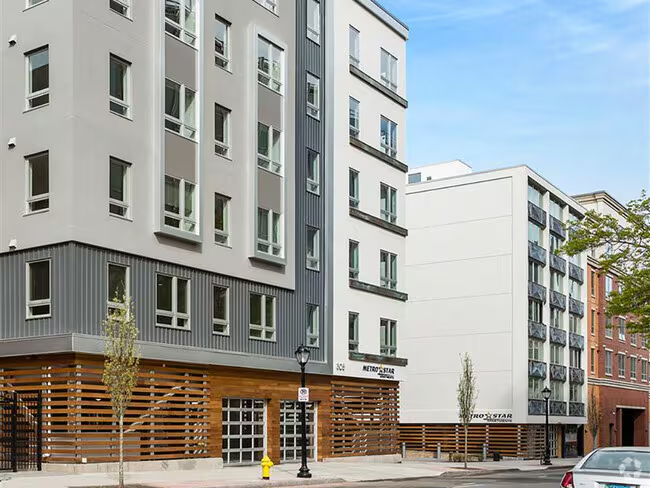
297 George Street
297 George Street, New Haven, CT 06510
The land that is now 297 and 299 George Street falls within New Haven’s original nine-square grid. In the second half of the 19th century, row houses were built on each of these properties. Then, in the first decade of the 20th century, 299 George Street became home to an automobile shop, which existed on the site until the middle of the century. 297 George Street continued to be residential during this period, changing hands frequently but often remaining within the same family for decades. By the middle of the century, New Haven city planners targeted these properties and their surroundings as a source of urban “blight”; consequently, the original plan for the highway that is now the Oak Street Connector used George Street as the project’s northern boundary. This location was eventually discarded in favor of one further south, where the Oak Street Connector can be found today. By 1957, the private development company Edgewood Realty had acquired both 297 and 299 George Street from their individual owners, and in 1964, Edgewood Realty sold both sites to Robert and Benjamin Baron of the Peter James Corporation, a New-Haven based real estate company. In the same year, the Peter James Corporation mortgaged the property for $360,000 in order to finance this purchase and construct a larger building on the combined site, now known simply as 297 George Street. The new building, constructed in 1965 and still standing today, is modern in style and was designed by the Connecticut-based architecture firm Simeone & Wendler. At seven stories high, the building was constructed with 36 apartment units. Of particular note on the building’s façade is the emphasis on these individual units, each identical but separated from each other by regularly spaced concrete posts. This concrete frame serves both a functional and a minimalist aesthetic purpose, with the tiles between the concrete posts affording little additional decoration. Though the building’s ground level was enclosed during a 2005 renovation, this space was originally open to the street and served as a car parking facility—an effort to ensure that this apartment building would be compatible with the modern automobile-oriented urban environment. Before the enclosure of the ground level, the building itself seemed to be raised on concrete stilts, as if to separate the residential space from the messiness of the street. During the 2005 renovation, the building’s surface also acquired its distinctive yellow color; in the original design, the building’s brown and gray tones allowed the structure to blend unobtrusively with the natural tones of the surrounding buildings. By the early 1970s, the building’s vacancy rates were high, at 20 percent by the end of 1971, as were rent delinquency rates. In March 1971, the Peter James Corporation sold the apartment building to The Center Corporation. This change in ownership did not directly affect the building’s tenants. However, in November of the same year, The Center Corporation sold the building to Rex Realty by way of the Branford Development Company. At this point, Rex Realty closed the building in order to renovate the apartments and rid the space of its so-called “undesirable” occupants, including drug traffickers and prostitutes. Rex Realty, a real estate investment company now known as M. F. DiScala Company, saw the apartment building as a potential “value-added” investment, recognizing that the building had been well constructed but required significant renovations and upgrades. Originally known as the “Peter James Apartments,” the building was renamed with the magisterial title “The Regency.” In recent decades, the apartments have remained under the ownership of M. F. DiScala Company and have managed to sustain occupancy rates around 95 percent. The apartments now cater primarily to Yale University graduate students.
M. F. DiScala and Company, Inc.
Researcher
Sarah Armitage
Date Researched
Entry Created
June 4, 2017 at 8:47 AM EST
Last Updated
July 3, 2025 at 1:53 PM EST by karinaencarnacion
Historic Name
The Peter James Apartments / Regency Hotel
Style
ModernistCurrent Use
Multiple Unit DwellingResidentialEra
1950-1980Neighborhood
Downtown and Town Green DistrictTours
Preservation & Renewal towards Trowbridge SquareYear Built
1965
Architect
Simeone and Wendler
Current Tenant
MetroStar Apartments
Roof Types
Structural Conditions
Good
Street Visibilities
Visible from the street
Threats
External Conditions
Good
Dimensions
7 stories; 48' x 90'
Street Visibilities
Visible from the street
Owner
MetroStar Apartments
Ownernishp Type
Private
Client
Jack and Mary DiScala Limited Partnership
Historic Uses
ResidentialMultiple Unit Dwelling


Comments
You are not logged in! Please log in to comment.